NUR 356 Nursing Theory I Exam 1 – Flashcards
Unlock all answers in this set
Unlock answersquestion
Represents thoughtful examination of phenomenon. Nursing theory: well defined view of professional nursing. Used to describe, predict and control phenomenon "Theory-based nursing care helps ensure consistency and constancy of professional nursing practice across clinical settings" (Arnold and Boggs, 2007, p. 2) 1) Cyclic relationship. 2) Observations, insights, & research lead to theory about a phenomenon. 3) Phenomena...relationships between two or more observable events, objects, or ideas. 4) Research findings are used in nursing practice.
answer
Nursing Theory:
question
Scholarly inquiry Link to evidenced-based practice Nursing knowledge: Link to other disciplines, Paradigm
answer
Nursing theory development:
question
When nurses or other clinicians use research findings and the best evidence possible to make decisions, the outcome is termed evidence-based practice. "When nurses' sensitivity to human needs is joined with the ability to find and use expert opinion, with the ability to find reported research and apply it to their practice, and when they themselves use the scientific method of investigation, there is no limit to the influence they might have on health care worldwide." Virginia Henderson, 1987
answer
Evidence Based Practice
question
"...if the practitioner knows what will happen in a given situation, the nurse can take steps to modify or control the situation." (Nichols & Zwelling, 1997, p. 7 )Definition of Nursing Practice
answer
Theory...POTENTIAL FOR CONTROL
question
Henderson, Rogers, Watson, Peplau
answer
Nurse leaders:
question
Nursing worldview that distinguishes the nursing profession from other disciplines and emphasizes its unique functional characteristics. The four key concepts: Person, environment, health and nursing are foundations for all nursing theories. Person Environment Health Nursing These concepts taken together comprise the nursing metaparadigm. Exploring the relationships between and among the above concepts is common to all professional nursing theories
answer
Nursing Metaparadigm
question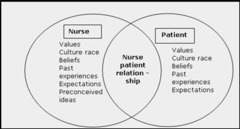
Interpersonal theory, can improve mental health Theory of interpersonal relationships Described nurse-client relationship as the foundation of nursing practice Developmental phases of relationship.

answer
Hildegard Peplau
question
Sigmund Freud: Value of talking about painful experiences Erik Erickson: Psychosocial development Abraham Maslow: Progressive stages of personal growth
answer
Nursing theory Contributions from other disciplines:
question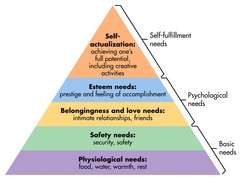
Helps to Prioritize interventions, and Meet people where they are. Physiological needs, Security Needs, Love & Belonging needs, Esteem needs, Experience purpose/meaning, self-actualisation.

answer
Maslow's Hierarchy of Needs:
question
"Communication is the cornerstone of a positive nurse-patient relationship" "Therapeutic communication involves the use of carefully selected communication interventions to help patients and families overcome stress and adjust to the unalterable"
answer
Nursing Communication
question
Send and receive messages Arrive at conclusions; reconstruct past; look to future Begin and/or modify physiologic processes Influence others
answer
Functions of Nursing Communication
question
Referent Sender and receiver Message Channel Feedback Interpersonal variable Environment
answer
7 Elements of Communication
question
Motivates one person to communicate with another. (Sights, sounds, odors, time schedules, emotions, sensations, perceptions) Considering the referent during an interaction helps the sender develop and organize the message. [Basic Elements of the Communication Process]
answer
Referent
question
Sender: Is the person who delivers the message. The roles of sender and receiver change back and forth as two persons interact. Receiver: You send the message to the receiver. The message acts as one of the receiver's referents, prompting a response. (The more the sender and receiver have in common and the closer the relationship, the more likely the receiver will accurately perceive the sender's meaning and respond appropriately.) [Basic Elements of the Communication Process]
answer
Sender and receiver
question
Is the content of the conversation, including verbal and nonverbal information the sender expresses. (The most effective message is clear, organized, and expressed in a manner familiar to both the sender and the receiver.) [Basic Elements of the Communication Process]
answer
Message
question
Is the means of conveying and receiving the message through visual, auditory, and tactile senses. (Example: Your facial expression sends a visual message, and spoken words travel through auditory channels.) Usually, the more channels the sender uses to convey a message, the more clearly the receiver will understand the message. [Basic Elements of the Communication Process]
answer
Channel
question
The message the receiver returns to the sender. Feedback indicates whether the receiver understood the meaning of the sender's message. Your positive intent is not enough to ensure accurate reception of a message. Seek verbal and nonverbal feedback from the receiver to be sure the receiver understands the message. [Basic Elements of the Communication Process]
answer
Feedback
question
Factors within both the sender and receiver that influence communication; perception is one such variable that provides a uniquely personal view of reality formed by an individuals expectations and experience. Each person senses interprets, and understands events differently.
answer
Interpersonal variable
question
The physical and emotional climate in which the interaction takes place. (Make the environment comfortable and suitable to the participants' needs for effective communication. the more positive an environment, the more successful the communication exchange.) [Basic Elements of the Communication Process]
answer
Environment
question
The sharing of information between individuals by using speech.
answer
Verbal Communication
question
A significant proportion of communication is non-verbal.
answer
Non-verbal
question
assertive presentation responsible communication caring
answer
Assertive, Responsible, Caring Communication requires:
question
Confident Clear Direct Respectful Genuine Leader
answer
Factors of an assertive presentation:
question
Actions based on knowledge Accountable for outcomes Problem-solving Use nursing process
answer
Factors of responsible communication:
question
Basis of nursing profession. "Caring is the moral ideal that guides nurses through the caregiving process, and knowledgeable caring is the highest form of commitment" Situation-specific Caring for self and colleagues
answer
Importance of caring:
question
process of using one's interactions for the benefit of another, involves awareness of oneself and values. Developing self-awareness and beginning to understand his or her attitudes, the nurse can begin to use aspects of his or her personality, experiences, values, feelings, intelligence, needs, coping skills, and perceptions to establish relationships with clients.
answer
Therapeutic use of self
question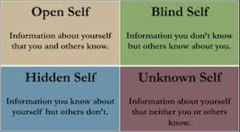
A visual representation of components of the self that are known or unknown to the self and to others. 4 panes represent the total self. Change in one affects all others. A small pane one - poorer communication. Interpersonal learning enlarges pane one.

answer
Johari Window
question
Listening to self and paying attention to emotions, thoughts, reactions. Listening to and listening from others. Self-disclosure.
answer
Self-awareness
question
Our efforts to understand our conduct by looking at yourself "in a mirror".
answer
Practical reflection
question
Purposeful Rapport Trust Empathy Goal directed
answer
5 Characteristics of a Therapeutic Relationship:
question
Self-awareness Openness Self confidence and strength Genuineness Concern for individual Knowledge Sensitivity Acceptance Creativity Ability to focus and confront Ability to empathize
answer
Qualities of Therapeutic effectiveness:
question
Caring Respect Trust Presence (being there, conveys hope) Mutuality (both parties committed) Empathy (I understand something about your world) Authenticity (being real, honest) Confidentiality
answer
Bridges of communication
question
Anxiety Attitudes Gaps Resistance Transference Sensory Failure to address concerns
answer
Barriers to communication
question
is a feeling of intrinsic motivation, in which a person perceive their self to have meaning and perceive themselves to be competent, having an impact, and capable self-determination. Self-efficacy: An individual's belief that he or she is capable of performing a task. Self esteem Value Mutuality: client involvement in the therapeutic relationship.
answer
Empowerment
question
Health care professionals' beliefs about what is best for patients may affect the decisions they make about their patients' diagnosis, prognosis or therapy. The nurse may choose to withhold information from the patient and family members. A policy of treating subject people as if they were children, providing for their needs but not giving them rights.
answer
Paternalism
question
...?
answer
maternalism
question
Pre-interaction Orientation Phase Working Phase Termination Phase
answer
4 Phases of Relationship
question
The period before first meeting with the client in which the nurse reviews information and prepares for the initial interview. Organize time Formulate professional goal Establish priorities Assess environment
answer
Pre-interaction
question
This phase begins when the nurse and client meet and ends when the client begins to identify problems to examine. Establish effective contact Identify clients needs Verbalize mutuality - health goals Establish therapeutic contract
answer
Orientation Phase
question
Phase of the therapeutic nurse-client relationship in which we use problem-solving model to work toward achievement of established goals. Develop mutuality Facilitate expressions of thoughts and feelings Define concern Explore possible solutions Develop realistic plan
answer
Working Phase
question
When the goals of the therapeutic relationship are achieved, both the client and caregiver share a sense of accomplishment. Evaluate goal achievement Identify clients strengths /areas of improvement Discuss termination If needed, develop follow up plans or referrals
answer
Termination Phase
question
Culture Non-English speaking Interpretor Age Infant Children Adolescent Elder Physical
answer
Considerations for Improving communication:
question
Emotion Subjective Without specific object - differentiates it from FEAR Communicated interpersonally Self-preservation "is a vague sense of apprehension that is accompanied by feelings of uncertainty, helplessness, isolation, and insecurity."
answer
Defining characteristics of Anxiety
question
Mild anxiety Moderate anxiety Severe anxiety Panic
answer
Levels of Anxiety
question
Alert, perceptual field increased Motivate learning & produce growth
answer
Mild anxiety
question
Focus only on immediate concern Narrowing of perceptual field Blocks out certain areas but can be redirected to attend to more
answer
Moderate anxiety
question
Significant reduction in perceptual field Focus on specific detail All behavior is aimed at relieving anxiety Much direction is needed to refocus
answer
Severe anxiety
question
Awe, tread, terror Details blown out of proportion Complete loss of control, unable to redirect
answer
Panic
question
Behavior responses Cognitive responses Affective responses Intensity of responses increases as anxiety increases Physiologic responses
answer
Behaviors associated with anxiety
question
Stress is the non specific response of the body to a stressor
answer
Stress
question
Stressors are life events that place a challenge, threat or demand upon an individual.
answer
Stressors
question
Seyle's concept that the body responds to stress with alarm, resistance and exhaustion. The body's response to an increased demand. The first stage is initial adaptive response aka fight or flight mechanism. If it is prolonged maladaptive responses can occur. Effective Coping Behavior stops GAS.

answer
3 stages General Adaptation Syndrome (GAS)
question
Identify Sources of Stress VS Buffers affecting Response
answer
Ways to deal with or overcome the negative effects of stress.
question
Extrinsic: no control over such as the death of a family member Intrinsic: stressors created or exacerbated by poor time management, poor communication, etc.
answer
Sources of Stress:
question
Resilience Hardiness Attitude Optimism
answer
Buffers affecting stress Response
question
Physiological Psychological Social/Behavioral Spiritual
answer
Consequences of stress
question
Assessment Interventions Primary prevention
answer
Stress Management
question
Identification of stress factors the person is experiencing, including which ones are causing the most stress
answer
Stress Assessment
question
Self-awareness Healthy diet Exercise Sleep Cognitive restructuring Social support Empathy Communication Recreation Spiritual practice Values clarification Goals Humor
answer
Stress Interventions
question
Goal is to prevent developmental and situational stressors from becoming crisis *Does not prevent stressors* *Does teach how to deal with stressors*
answer
Primary prevention
question
Perception of the event Situational support Coping mechanisms
answer
Stress Balancing Factors
question
a situation or time that is extremely dangerous or difficult Developmental Situational Adventitious
answer
crisis Types of crisis
question
all our thoughts and feelings about ourselves, in answer to the question, "Who am I?" " consists of all the values, beliefs and ideas that contribute to a person's self-knowledge and influences relationships with others, including one's perception of personal characteristics and abilities and one's goals and ideals." Developmental influences Significant Others Self Perceptions
answer
Self-Concept
question
Body Image Sum of the conscious and unconscious attitudes toward the: Self Ideal Perception of how one should behave, based on certain personal standards Self-esteem Personal judgment of one's worth Role performance Socially accepted behavior patterns Personal Identity
answer
Components of the Self
question
A negative, reduced sense of self-worth that is often linked to delinquency where an individual lacks self-respect and self-assurance. Self criticism Self diminution Guilt and worry Physical manifestations Postponing decisions Punishing self Disturbed relationships Withdrawal from reality Self destructive Other destructive Illusions Exaggerated sense of self Boredom Polarizing view of life
answer
Low Self-Esteem
question
(11 heath patterns) is a method devised by Marjory Gordon to be used by nurses in the nursing process to provide a more comprehensive nursing assessment of the patient.
answer
Gordon's Functional Health Patterns (FHPs)
question
1) Holism and the totality of the person's interactions with the environment form the philosophical foundations of Gordon's functional health patterns. 2) "View the individual as a whole being using interrelated behavioral areas". 3) "Nurses can perceive and record complex interactions of the individuals biophysical state, psychological make up and their relationship to the environment. 4) Data is collected and organized into the Functional Health Patterns (FHPs). Assessment information is displayed as a concept map.
answer
Gordon's Functional Health Patterns Defined by 4 points:
question
1) The 11 patterns serve as an assessment tool to collect and organize data. 2) Historically is the most accepted framework for assessment in all areas of nursing. 3) Identify areas of strength, limitation, alteration, and response to therapies. 4) Provides the foundation for nursing diagnoses, actual and potential. 5) Provides for more effective nursing interventions and outcomes that promote health and well-being
answer
5 points why Gordon's Functional Health Patterns are used:
question
1) Provide a consistent nursing focus through a means of collecting, organizing, presenting, and analyzing data to arrive at a nursing diagnosis 2) Format is flexible and tailored to the individual, situation, and nurse. 3) Information collected is suitable to any area of practice, such as the home or clinic, and whether assessing individual (child or adult), family, or community.
answer
3 Advantages of FHP's
question
Client in the center surrounded by: Mutritional/Metabolic Health PerceptionsManagment Eliminiation Activity/Exercise Sleep/Rest Cognitive/Perceptual Self Concept Roles/Relationships Sexuality/Reproductive Coping/Stress Values/Beliefs
answer
Gordon's FHPs illustrated in Concept Map
question
1) Pattern Focus 2) Individual-environmental focus 3) Age-developmental focus 4) Functional focus 5) Cultural focus
answer
FHP Characterized by 5 Areas of Focus
question
patterns or sequences of behavior over time. Example: blood pressure, activity, exercise
answer
Pattern Focus
question
Role relationship, family values, and societal mores. Example: parents control nutritional intake of children
answer
Individual-environmental focus
question
Growth and development; developmental tasks
answer
Age-developmental focus
question
Individuals performance levels. Example: Surgeon's focus is pt.'s ability to void after bladder surgery; nurses also look at the ability to perform activities such as shopping or socializing, climbing stairs to bathroom, can pt. manage care independently
answer
Functional focus
question
Culturally competent care is delivered with knowledge of and sensitivity to cultural factors influencing health behavior.
answer
Cultural focus
question
Gordon's functional health patterns are used as an assessment tool in the nursing process. "The nursing process is "the systematic approach to reduce or eliminate the individuals health problem". Systematic problem-solving method by which nurses individualize care for each client. The five steps: 1) assessment 2) diagnosis 3) planning 4) implementation 5) evaluation
answer
Nursing Process (5 steps)
question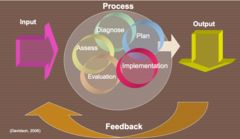
Input -> Process (Diagnose, Plan, Assess, Evaluation, Implementation) -> Output -> Feedback -> Input ...

answer
Nursing Process Overview
question
First step in the nursing process Individualized, Description of client's health status Organization of interdependent parts describing, Health, function, or patterns of behavior that reflect the whole individual and environment
answer
Assessment (Overview)
question
Data collection: Interview, observation, examination. 1. Subjective data- what the client states; health history Example: "I have to get up to the toilet three times a night". 2. Objective data- nurse observation; physical exan findings; Information from health records; results from clinical tests Example: lab results from the client's chart.
answer
Process of Assessment (2x)
question
Health PerceptionsManagment Mutritional/Metabolic Eliminiation Activity/Exercise Sleep/Rest Cognitive/Perceptual Self Concept Roles/Relationships Sexuality/Reproductive Coping/Stress Values/Beliefs
answer
Assessment using Gordon's FHP's (11 functional health patterns)
question
1) Perceived health and well-being and how health is managed. 2) Health and safety practices 3) Use of health care system 4) Previous adherence/compliance pattern 5) Knowledge of health services 6) Health care seeking patterns 7) Access to health care 8) What are their beliefs about health
answer
FHP : Health perceptions/management
question
1) Food/Fluid consumption patterns 2) Satisfaction 3) Nutrient intake 4) Metabolic needs 5) Preferences 6) Problems
answer
FHP: Nutrition/metabolic
question
1) Function of Bowel/Bladder/Skin 2) Regularity/Control 3) Perceived problems 4) Changes
answer
FHP: Elimination
question
1) Sleep adequacy (quality/quantity) 2) Rest 3) Relaxation 4) Energy levels 5) Perceived problems/changes
answer
FHP: Sleep/rest
question
1) Exercise 2) Daily/Leisure activity-recreation 3) Movement capability 4) Activity tolerance 5) Self-care abilities 6) Use of assistive devices 7) Satisfaction level 8) Perceived problems 9) Changes 10) Vital signs
answer
FHP : Activity/exercise
question
1) Ability to follow/understand directions 2) Retain information 3) Decision making 4) Problem solving 5) Language 6) The 5 senses (taste, smell, see, touch, hear) 7) Pain
answer
FHP: Cognitive/perceptual
question
The individuals perception/satisfaction with: 1) Social circumstances- family, friends, work 2) Role responsibilities 3) Loss 4) Change 5) Threat
answer
FHP: Roles/relationships
question
1) Sexual self-concept 2) Sexual functioning 3) Intimacy patterns 4) Reproductive issues 5) Satisfaction 6) Cultural influences
answer
FHP: Sexuality/reproductive
question
1) Perception/level of stress 2) Ability to manage stress 3) Sources of support 4) Defense/coping mechanisms 5) Alterations to coping pattern
answer
FHP: Coping/stress/tolerance
question
1) Health belief model 2) Spiritual beliefs, Religious practices 3) Personal values 4) Perception of right/wrong 5) Value conflicts? 6) Environmental influences
answer
FHP: Values/beliefs
question
1) Personal identity 2) Self-image 3) Sense of worth 4) Relationship patterns 5) Developmental level 6) Changes
answer
FHP: Self concept/self perception
question
Functional: (+) Dysfunctional: (-) Potentially dysfunctional: (+/-) S(+/-) = Patient O(+/-) = Observation
answer
Analysis of data (Analyze patterns)
question
American Nurses Association, Social Policy Statement, 2003 "Nursing is the protection, promotion, and optimization of health and abilities, prevention of illness and injury, alleviation of suffering through the diagnosis and treatment of human response, and advocacy in the care of individuals, families, communities, and populations." (American Nurses Association [ANA], 2003) as cited in Edelman & Mandle , 2010, p.148).
answer
Definition of Nursing Practice
question
A dynamic and organized process. Uses information purposefully to provide care for clients. Individualized, holistic, effective, and efficient.
answer
Nursing Process
question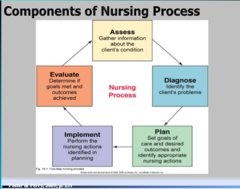
Systematic and Organized method. Used to plan and provide services as defined within nursing practice. Allows for individualized care. Assessment Nursing Diagnosis Planning Implementation Evaluation

answer
Components of Nursing Process Overview
question
Systematic, comprehensive collection of data. The complete physical examination Health history Functional health patterns Physical assessment findings Diagnostic Laboratory data FHP framework used to organize data. "learn as much as possible about the individual." Are health problems present? Status of health promotion activities? Client's perception and goals for health and alterations in health state
answer
Assessment
question
Concept Map and analysis of FHP's. Nursing diagnosis Identifies the response to actual or potential health problems or life processes. Provides the base for developing the plan of care. NANDA taxonomy endorsed by ANA a statement about the client's actual or potential health concerns that can be managed through independent nursing intervention.
answer
Nursing Diagnosis
question
Actual: real problems. Validated by presence of defining characteristics. Risk: potential problems Possible: suspected problem requiring more data Wellness: focus is on higher level wellness Syndrome: eg. Rape Trauma Syndrome
answer
Types of nursing diagnoses
question
P-E-S proposed by Gordon, 1994 P=problem E=etiology S=signs & symptoms Three part statement. Example: Impaired Skin integrity related to imposed immobility secondary to sedation as evidenced by 2cm lesion on coccyx, stage 2. P=problem Impaired Skin Integrity E=etiology Related to imposed immobility secondary to sedation S=signs & symptoms Evidenced by: 2 cm lesion on coccyx-stage 2 pressure ulcer
answer
Actual Nursing Diagnosis
question
Nursing diagnosis should NOT be related to a medical diagnosis. HOWEVER The use of a medical diagnosis may add clarity to the diagnosis. The nurse can link it to the statement with the phrase "secondary to".
answer
Actual Nursing Diagnosis
question
-Disturbed self concept -Related to-weakness and the need to use a wheelchair secondary to multiple sclerosis -as evidenced by client stating "my sister has to come and clean my house now for me." "I feel useless as I can't clean it myself."
answer
Actual Nursing Diagnosis
question
Two part statement: "a clinical judgment that an individual, family or community is more vulnerable to develop the problem than others in the same or similar situation" At risk for label R/T risk factors Example: At risk for impaired skin integrity related to urinary incontinence and being confined to bed.
answer
At Risk Nursing Diagnosis
question
Possible Nursing Diagnosis : -Temporary, pending more data to confirm or to rule out a problem -2 part statement -Possible Label R/T Risks, Causes (No S&S) Wellness Diagnosis: -Present function is effective -Person desires higher level wellness -One part statement -Readiness for enhanced (label) followed by higher level wellness that the client or group desires. -No related factors or S&S
answer
Possible Nursing Diagnosis VS. Wellness Diagnosis
question
Compromises of a cluster of predicted actual or high-risk nursing diagnoses related to a certain situation or event. Usually one part statement with the etiological or contributing factors contained in the diagnostic label-Rape Trauma Syndrome.
answer
Syndrome Diagnosis
question
"Certain physiologic complications that nurses monitor to detect onset or changes in status. Nurses manage collaborative problems using physician- prescribed and nursing-prescribed interventions to minimize the complications of the events." Nurses can prevent: 1) Aspiration 2) Pressure ulcers Nursing diagnosis: 1) Risk for aspiration 2) Risk for impaired skin integrity Nurses can treat: 1) Stage 1 pressure ulcer Nursing diagnosis: 1) Impaired skin integrity Nurse cannot prevent 1) Bleeding Collaborative problem 1) Bleeding
answer
Collaborative Problems
question
Nursing Diagnosis Assessment: Data collection to identify S & S of actual nursing diagnoses or risk factors. Collaborative Problem Assessment: -Determining physiologic stability or risk for instability. -Usually associated with a particular pathology or treatment. -Can the nurse monitor the condition? -The nurse monitors hypo/hyperglycemia not diabetes mellitus.
answer
Nursing Diagnosis VS Collaborative Problem
question
-Establishing a priority set of diagnoses -Designating client and nursing goals -Prescribing nursing intervention Types -Nurse-prescribed (Independent) -Physician-prescribed (Dependent) Implementation considerations -Assistance, time, money, equipment
answer
Planning (3 components)
question
S-Specific to patient, nursing diagnosis, content and time M-Mutual (patient and nurse) M-Measurable A-Achievable R-Realistic T-Time-limited Goals can be long or short-termed.
answer
Expected Outcomes
question
This component involves applying the skills to implement the nursing interventions. Most frequently used nursing interventions in health promotion include: 1. Screening 2. Education 3. Counseling 4. Crisis intervention -Feedback process continues throughout all phases of the nursing process. -Nurses continually collect data and modify the plan as needed.
answer
Implementation
question
Evaluation of the client's status. Evaluation of the client's progress toward goal achievement. Evaluation of the plan of care's status and currency One of two conclusions about the patient outcome: It was met OR It was not met
answer
Evaluation
question
Are the interventions realistic for the client? Are the goals attainable? Do all care providers participate in the plan? Is the environment friendly to change? Is the client motivated? A change in the plan of care may be required: Adjust ND Expected outcomes Interventions
answer
Variables in Evaluation
question
Nursing process with families is a two level process. Family as a group; family member as an individual. Assessment of the physical environment very important. Incorporates multiple theories and perspectives; -system, developmental stage, risk-factor, FHP analysis.
answer
Family System



